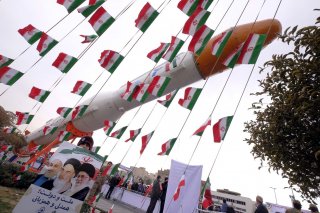Meet Iran’s Simorgh Missile: Made with Help from North Korea
Tehran gets by with a little help from its friends.
The DPRK supplied missile components to Iran—for a rocket that Tehran claims is peaceful.
Birds of a Feather
Iran and North Korea enjoy surprisingly close relations when it come to arms and weapons. Iran imports a lot of DPRK tech—long range artillery, tanks, the list goes on. One of Iran’s more recent arms import is the Simorgh missile.
The relatively new Iranian Space Agency has been testing various long-range missiles since the agency’s inception in 2004. These missiles typically used engines from another long-range Iranian rocket, the Shaham-3. In 2008, Iran joined the small club of countries that have successfully put a satellite into orbit using domestically-designed rockets.
The Simorgh missile is relatively small for a rocket intended to launch satellites. It has four-rocket engines and is supposed to use Scud missile technology from around the 1960s. Though the Simorgh is ostensibly a part of Iran’s space program, it could be adapted for use in long-range ballistic missiles.
Satellites are all well and good, and usually used for peaceful purposes. What is worrying about Iran’s satellite launch is not the satellites themselves, but the rocket technology that went into getting Iran’s satellites airborne.
Foreign Aid
The United States intelligence community has concluded that the DPRK supplied Iran with “design data, stage separation technology, and booster equipment” that was used for designing the Simorgh. This conclusion is based on intel reports that assert rocket parts were seen leaving North Korea for Iran and show how the DPRK and Iran remain intertwined via arms deals.
Ballistic Hopes and Dreams
The Simorgh can only transport smaller payloads into Earth’s lower orbit. Its estimated payload capability is under 100 kilograms, or around 220 pounds. A nuclear warhead weighs in the 500 to 1,000 kilo range, or about 1,100-2,200 pounds. Not exactly a big threat.
Range is also an issue. The Simorgh can reach approximately 500 kilometers in altitude, nowhere near the 10,000+ kilometers necessary to put the continental United States within range. Furthermore, for the Simorgh to be a functional ICBM, it would need not only to roughly double its maximum altitude to around 1,000 kilometers, it would also need to survive reentry into Earth’s atmosphere.
Reentry is one of the most hazardous parts of an ICBM trajectory. The high speeds at which an ICBM enters the Earth’s atmosphere generates a huge amount of heat that an ICBM needs to be properly shielded against. Not only that, but onboard targeting and navigational instruments have to survive the intensely turbulent reentry.
Postscript
Yes, Iran says that putting satellites into orbit is for peaceful purposes, but putting a satellite into space has more than one purpose. A 2017 intelligence analysis said that “progress in Iran’s space program could shorten a pathway to an ICBM because space launch vehicles (SLV) use inherently similar technologies.” The report explained that the Simorgh “could serve as a test bed for developing ICBM technologies.” Perhaps Tehran’s intentions are not so pure after all.
Caleb Larson holds a Master of Public Policy degree from the Willy Brandt School of Public Policy. He lives in Berlin and writes on U.S. and Russian foreign and defense policy, German politics, and culture.
Image: Reuters

